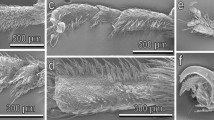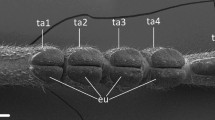Abstract
The attachment ability of insects on surfaces are associated not only with the micro- and nanostructure of the adhering part of an attachment device, but also with the global scale kinematics responsible for contact formation and release. In the present study, the locomotory techniques of several representatives of insects from four different orders (Orthoptera, Heteroptera, Coleoptera, and Hymenoptera), possessing different types of attachment structures, are described. The study is based on video recordings of insects walking on a flat surface and on cylindrical rods of various thickness, imitating plant stems. Attachment devices of tarsi and pretarsi were visualized using Scanning Electron Microscopy. The results show a different manner in the use of adhesive structures on substrates with various curvatures. Insects bearing attachment pads on proximal tarsomeres usually touch flat and curved substrates using all tarsomeres, whereas insects with their attachment devices on the distal tarsomeres usually walk on flat surfaces using the distal tarsomeres of the overextended tarsus. On substrates, with diameters comparable to or larger than the tarsus length, insects walk above the stem by clasping the stem with the bent tarsi. On thin stems, insects clasp the stem between their tarsi and hang under the stem. Thus, on thin and thick rods, forces applied to attachment organs act in opposite directions. There are two methods of leg positioning for walking on a rough flat substrate. In the first case, the tarsus is straightened and the rough substrate is gripped between the claws and the proximal complex of attachment devices (tarsal euplantulae, fossulae spongiosa, and terminal spurs of tibiae). In the second case the tibia does not touch the substrate; the insect is supported only by distal tarsomeres. The tarsus is in an overextended condition. On rods, with diameters comparable to or larger than the tarsus length, insects walk by clasping the stem with the bent tarsi. This posture is characteristic for the majority of insects independent of the tarsal position they normally use while walking on a plane. If the rod’s diameter is smaller than the tarsus length, walking insects usually clutch it between contralateral tarsi. Using such a posture they are supported by interlocking or by strong friction, generated by attachment devices of the proximal tarsomeres, and do not use attachment devices of the pretarsus. Contact with the substrate is reinforced due to the coordinated contralateral clutch using all supporting legs. It is concluded that the use of different types of attachment structures correlates with locomotory techniques.

















Similar content being viewed by others
References
Betz O (2002) Performance and adaptive value of tarsal morphology in rove beetles of the genus Stenus (Coleoptera, Staphylinidae). J Exp Biol 205:1097–1113
Beutel RG, Gorb SN (2001) Ultrastructure of attachment specializations of hexapods (Arthropoda): evolutionary patterns inferred from a revised ordinal phylogeny. J Zool Syst Evol Res 39:177–207
Beutel RG, Gorb SN (2006) A revised interpretation of the evolution of attachment structures in Hexapoda with special emphasis on Mantophasmatodea. Arthropod Syst Phylogeny 64:3–25
Dai Z, Gorb SN, Schwarz U (2002) Roughness-dependent friction force of the tarsal claw system in the beetle Pachnoda marginata (Coleoptera, Scarabeidae). J Exp Biol 205:2479–2488
Daltorio KA, Horchler AD, Gorb S, Ritzmann RE, Quinn RD (2005a) A small wall-walking robot with compliant, adhesive feet. In: Proceedings of the 2005 IEEE/RSJ international conference on intelligent Robots and systems (IROS ‘05), August 2–6, 2005, Edmonton, Canada, pp 4018–4023
Daltorio KA, Gorb S, Peressadko A, Horchler AD, Ritzmann RE, Quinn RD (2005b) A robot that climbs walls using micro-structured polymer feet. In: Proceedings of the international conference on climbing and walking robots (CLAWAR), September 13–15, 2005, London, UK, pp 131–138
Dixon AFG, Croghan PC, Gowing RP (1990) The mechanism by which aphids adhere to smooth surfaces. J Exp Biol 152:243–253
Ermolenko VM (1972) Horntails and saw-flies. Part 2 Tenthredinoidea. Fauna of the Ukraine. Band 10. Naukova Dumka Publishers, Kiev, p 204
Federle W, Brainerd EL, McMahon TA, Hölldobler B (2001) Biomechanics of the movable pretarsal adhesive organ in ant and bees. Proc Natl Acad Sci USA 98:6215–6220
Frantsevich LI, Cruse H (1997) The stick insect, Obrimus asperrimus (Phasmida, Bacillidae) walking on different substrates. J Insect Physiol 43:447–455
Frantsevich LI, Cruse H (2005) Leg coordination during turning on an extremely narrow substrate in a bug, Mesocerus marginatus (Heteroptera, Coreidae). J Insect Physiol 51:1092–1104
Frantsevich L, Gorb S (2002) Arcus as a tensegrity structure in the arolium of wasps (Hymenoptera: Vespidae). Zoology 105:225–237
Frantsevich L, Gorb S (2004) Structure and mechanics of the tarsal chain in the hornet, Vespa crabro (Hymenoptera: Vespidae): implications on the attachment mechanism. Arthropod Struct Dev 33:77–89
Frantsevich LI, Mokrushov PA, Shumakova ID, Gladun DV (1995) Kinematics of insect walking on narrow ground. Vestn Zoologii 4:41–48
Frantsevich LI, Mokrushov PA, Shumakova ID, Gorb SN (1996) Insect rope-walkers: Kinematics of walking on thin rods in a bug, Graphosoma italicum (Heteroptera, Pentatomidae). J Zool 238:713–724
Frazier SF, Larsen GS, Neff D, Quimby L, Carney M, DiCaprio RA, Zill SN (1999) Elasticity and movements of the cockroach tarsus in walking. J Comp Physiol A 185:157–172
Full RJ, Jamauchi A, Jindrich DL (1995) Maximum single leg force production: cockroach righting on photoelastic gelatin. J Exp Biol 198:2441–2452
Gao H, Wang X, Yao H, Gorb S, Arzt E (2004) Mechanics of hierarchical adhesion structures of geckos. Mech Mater 37:275–285
Gillett JD, Wigglesworth VB (1932) The climbing organ of an insect, Rhodnius prolixus (Hemiptera, Reduviidae). Proc R Soc Lond B 111:364–376
Gorb EV, Gorb SN (2002) Attachment ability of the beetle Chrysolina fastuosa on various plant surfaces. Entomol Exp Appl 105:13–28
Gorb SN (1998) The design of the fly adhesive pad: distal tenent setae are adapted to the delivery of an adhesive secretion. Proc R Soc Lond B 265:747–752
Gorb SN (2001) Attachment devices of insect cuticle. Kluwer, Dordrecht, Boston, London, p 305
Gorb SN, Beutel RG (2001) Evolution of locomotory attachment pads of hexapods. Naturwissenschaften 88:530–534
Gorb SN, Gorb EV (2004) Ontogenesis of the attachment ability in the bug Coreus marginatus (Heteroptera, Insecta). J Exp Biol 207:2917–2924
Gorb S, Jiao Y, Scherge M (2000) Ultrastructural architecture and mechanical properties of attachment pads in Tettigonia viridissima (Orthoptera Tettigoniidae). J Comp Physiol A 186:821–831
Gorb S, Scherge M (2000) Biological microtribology: anisotropy in frictional forces of orthopteran attachment pads reflects the ultrastructure of a highly deformable material. Proc R Soc Lond B 267:1239–1244
Hanna G, Barnes W-JP (1990) Adhesion and detachment of the toe pads of tree frogs. J Exp Biol 155:103–125
Hassenstein B, Hustert R (1999) Hiding responces of locusts to approaching objects. J Exp Biol 202:1701–1710
Imms AD (1951) A general textbook of entomology, including the anatomy, physiology, development and classification of insects. Methuen, London, p 727
Jiao Y, Gorb SN, Scherge M (2000) Adhesion measured on the attachment pads of Tettigonia viridissima (Orthoptera, Insecta). J Exp Biol 203:1887–1895
Kazakova IG (1988) Morphological adaptations of Acrididae to the use of grasses as substrates for feeding, migration, and oviposition. In: Zolotarenko GS (ed) Landscape ecology of insects. Nauka Publishers, Novosibirsk, Russia, pp 26–34
Kendall UD (1970) The anatomy of the tarsi of Schistocerca gregaria Forskål. Z Zellforsch Mikrosk Anat 109:112–137
Kennedy CE (1986) Attachment may be a basis for specialization in oak aphids. Ecol entomol 11:291–300
Nachtigall W (1996) Locomotory behaviour in a population of the tiger beetle species Cicindella hybrida on a small, hot, sandy area (Coleoptera: Cicindellidae). Entomol Gen 20:241–248
Niederegger S, Gorb SN, Jiao Y (2002) Contact behavior of tenent setae in attachment pads of the blowfly Calliphora vicina (Diptera, Calliphoridae). J Comp Physiol A 187:961–970
Niederegger S, Gorb S (2003) Tarsal movements in flies during leg attachment and detachment on a smoothe substrate. J Insect Physiol 49:611–620
Peressadko AG, Gorb SN (2004a) When less is more: experimental evidence for tenacity enhancement by division of contact area. J Adhes 80:1–15
Peressadko AG, Gorb SN (2004b) Surface profile and friction force generated by insects. In: Boblan I, Bannasch R (eds) First international industrial conference Bionik, April 22–23, 2004, vol 15. Fortschritt-Berichte VDI, Hannover, Germany, pp 257–263
Perez Goodwyn P, Peressadko A, Kastner V, Schwarz H, Gorb S (2006) Material structure, stiffness and adhesion: why attachment pads of the grasshopper (Tettigonia viridissima) adhere more strongly than those of the locust (Locusta migratoria) (Insecta: Orthoptera). J Comp Physiol A 192:1233–1243
Persson BNJ, Gorb S (2003) The effect of surface roughness on the adhesion of elastic plates with application to biological systems. J Chem Phys 119:11437–11444
Ridgel AL, Ritzmann RE, Schaefer PL (2003) Effects of aging on behavior and leg kinematics during locomotion in two species of cockroach. J Exp Biol 206:4453–4465
Ritzmann RE, Gorb S, Quinn RD (2004) Arthropod locomotion systems: from biological materials and systems to robotics. Arthropod Struct Dev 33:183–185
Russell AP (1975) A contribution to the functional analysis of the foot of the Tokay, Gekko gecko (Reptilia, Gekkonidae). J Zool Lond 176:437–476
Schulmeister S (2003) Morphology and evolution of the tarsal plantulae in Hymenoptera (Insecta), focussing on the basal lineages. Zool Scr 32:153–172
Slifer EH (1950) Vulnerable areas on the surface of the tarsus and pretarsus of the grasshopper (Acrididae, Orthoptera) with special reference to the arolium. Ann Entomol Soc Am 43:173–188
Snodgrass RE (1956) Anatomy of the honeybee. Comstock Publication Association, Ithaca, p 334
Vötsch W, Nicholson G, Müller R, Stierhof Y-D, Gorb S, Schwarz U (2002) Chemical composition of the attachment pad secretion of the locust Locusta migratoria. Insect Biochem Mol Biol 32:1605–1613
Walther C (1969) Zum Verhalten des Krallenbeugersystem bei der Stabheuschrecke Carausius morosus Br. Z Vergleichende Physiol 62:421–460
Weirauch C (2005) Pretarsal structures in Reduviidae (Heteroptera, Insecta). Acta Zool 86:91–110
Acknowledgments
This work was supported by the grant 05.07/00194 of SFFR (State Fund of Fundamental Research, Ukraine) and by the Federal Ministry of Education, Science and Technology, Germany (project InspiRat 01RI0633C). The authors thank V. M. Ermolenko and P. V. Puchkov for the identification of insects used in this study. Both authors greatly appreciate the valuable criticism and suggestions of L. I. Frantsevich (Schmalhausen Institute of Zoology, Kiev, Ukraine) as well as linguistic corrections of V. Kastner (Tübingen, Germany).
Author information
Authors and Affiliations
Corresponding author
Additional information
Handling Editor: Heikki Hokkanen
Rights and permissions
About this article
Cite this article
Gladun, D., Gorb, S.N. Insect walking techniques on thin stems. Arthropod-Plant Interactions 1, 77–91 (2007). https://doi.org/10.1007/s11829-007-9007-2
Received:
Accepted:
Published:
Issue Date:
DOI: https://doi.org/10.1007/s11829-007-9007-2




